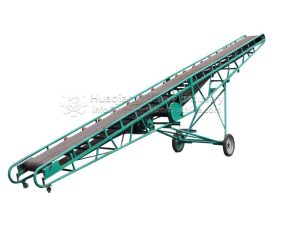Mobile belt conveyor, as key conveying equipment in fertilizer granulation production lines, form a complete material handling system alongside the granulator.

The core structure of a mobile belt conveyor includes a drive pulley, belt, idlers, frame, and travel wheels. It offers the following advantages:
Flexible and maneuverable – Equipped with either universal wheels or a tracked chassis, the machine can be easily adjusted to suit various operating scenarios, such as warehouse loading and unloading, field fertilization, or material transfer within a fertilizer production line.
Efficient and energy-efficient – Powered by either electric or diesel engines, it delivers fast conveying speeds and heavy loads. It can be tilted to accommodate stacking needs, reducing manual handling costs.
Adaptable – Belt materials available include rubber, PVC, or steel wire, offering corrosion-resistant and non-slip properties. It is suitable for a variety of materials, including granular and powdered fertilizers.
In fertilizer production, mobile belt conveyors are often used in conjunction with fertilizer granulators. Common fertilizer granulators include disc granulator, rotary drum granulator, and double roller press granulator. Mobile belt conveyors transport raw materials (such as crushed organic fertilizers and fertilizer mixtures) to the granulation section, or transport finished granules to the packaging area to achieve assembly line operations.
In actual fertilizer granulation production lines, mobile belt conveyors and fertilizer granulators form an efficient production line: powdered raw materials are fed into the fertilizer granulator via a belt conveyor for molding, and the belt conveyor then transports the molded fertilizer granules to drying, cooling, or packaging.
The combination of mobile belt conveyors and fertilizer granulators offers low costs and high returns, helping to improve the quality and efficiency of the fertilizer industry.


